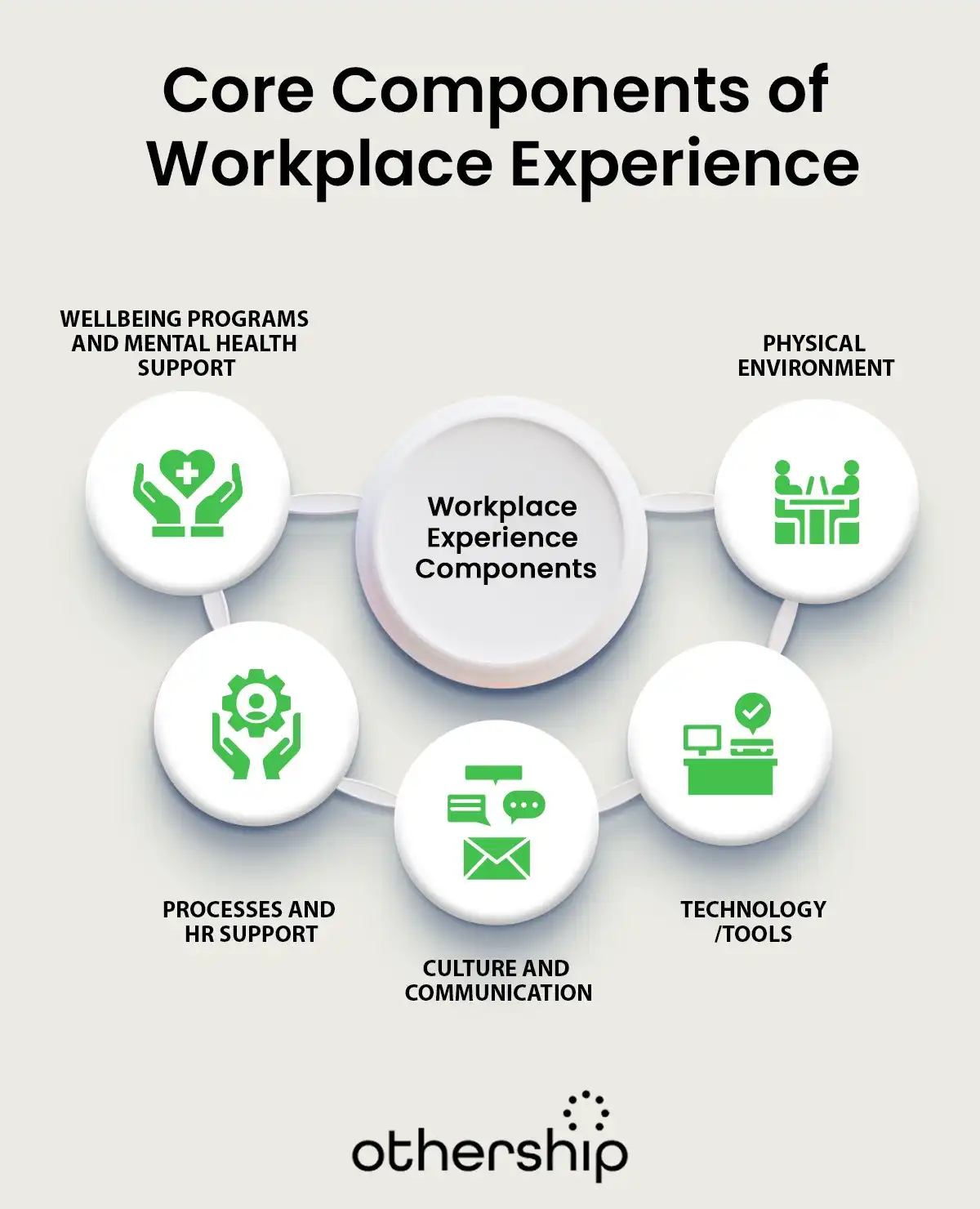In today’s rapidly changing work environment, creating an engaging and productive workplace experience has become more crucial. An experience that refers to the way employees interact with their work environment, encompassing the physical workspace, tools, and the overall work culture.
Strong office experience has become an essential factor for companies in maintaining connections amid changes, such as the hybrid and remote setups that have redefined the operating models of all businesses. Still, a worthwhile experience can ensure that both on-site and virtual settings have the same level of support and belonging.
In this article, discover the factors that impact employees’ experience and how companies can build the proper workplace for their team members to succeed and be satisfied.
Contents
- 1 What is Workplace Experience?
- 2 Workplace Experience vs. Employee Experience
- 3 Core Components of Workplace Experience
- 4 Why It Matters
- 5 Workplace Experience in Hybrid and Remote Settings
- 6 Examples of Great Workplace Experience
- 7 What is it that these three big companies are doing right?
- 8 How to Improve Workplace Experience?
- 9 Workplace Experience vs Office Design
- 10 The Future of Workplace Experience
- 11 Conclusion
What is Workplace Experience?
It refers to employees’ day-to-day interactions with their physical environment, digital tools, and the organizational culture. Some of its factors include office layout, technology availability, and the functionality of communication and support systems.
An employee’s experience in the workplace is also a sum up of what they see, feel, and encounter during their time at work. It is also about how the company or organization brings support, connection, and empowerment to everyone.
Hence, it is about the workplace vibe, from the ease of collaboration to clarity of communication, and everyone’s sense of purpose and belongingness.
Workplace Experience vs. Employee Experience
- The workplace experience definition is explicitly concerned with all the factors that contribute to an environment for work, including the tools, space, and support that truly enable people to do their jobs effectively.
- Meanwhile, employment experience means it is more extensive. It encompasses every interaction an employee has with a company, including recruitment, onboarding, performance evaluations, and exit interviews.
Core Components of Workplace Experience
An excellent experience in the workplace doesn’t just offer edge-level benefits, but creates a foundation through thoughtful design, meaningful technology, a supportive culture, and processes that focus on employees.

Here is the list of core elements that make a practical and meaningful workplace experience:
1. Physical Environment (office layout, coworking setups)
A physical workspace affects the level of comfort, focus, and collaboration an employee experiences daily. A flexible office design offers a positive office experience, enhancing productivity and overall wellness.
2. Technology/tools (apps, desk booking, seamless IT support)
It is no longer possible to describe modern work experiences without referring to the tools people need to accomplish their work. Technology and software solutions have allowed workers to create a more seamless workflow that caters to both in-office and remote work environments.
3. Culture and communication
A positive workplace culture forms the basis for valuable employee experiences. It encompasses open communication, mutual respect, and shared inclusive values, all of which nurture a culture of belonging.
4. Processes and HR support
Every great employee experience is built on streamlined processes. There is a reliable procedures that eliminate friction and empower employees. Additionally, employees feel that their HR processes are well-structured because of the support they receive.
5. Wellbeing programs and mental health support
Today’s stressful work environments make it crucial for employees to receive mental and physical health support; investing in wellbeing is wise for developing resilience and loyalty in a workforce.
Why It Matters
Creating an experience in the workplace is one of the most effective ways to offer value and benefits, as it fosters an employee-centric work environment where employees feel engaged, supported, and inspired. Investing in the workplace experience does have its benefits and advantages:
- Impact on retention – Team members will likely stay where they are supported.
- Productivity – A strong, positive work culture enables team members to be more productive and loyal.
- Satisfaction – Satisfaction fuels employees’ performance and creativity.
- Employer Brand – Words travel quickly; good talent draws attention to positive experiences.
Workplace Experience in Hybrid and Remote Settings
The transition from a physical workplace to a remote or hybrid setup has led organizations to reassess their views on the workplace experience.
Traditional office perks may not be enough compared to hybrid or remote work settings. Hence, companies are now investing in technological advancements that enhance productivity and collaboration.
As workplace experience has become increasingly crucial, it has become clear how it bridges the gap between the physical and virtual environments.
1. From Physical to Digital
The transition from in-person meetings to using tools like Zoom, Microsoft Teams, Slack, and shared workspaces, such as those provided by Google Workspace and Notion.
2. From Scheduled to Asynchronous
Flexible working hours are essential for employees who work in different time zones or have irregular schedules. Tools like Loom, Asana, or Trello enable asynchronous updates and collaboration.
3. From On-site support to Virtual Assistance
In the shift from On-site support to Virtual Assistance, companies can integrate services like a Virtual Medical Assistant to enhance remote well-being and provide timely health support digitally. IT support, HR services, and the onboarding process should work like well-oiled machines in a virtual world.
Examples of Great Workplace Experience
A great workplace establishes high standards through innovative practices, strong employee engagement, and an evident commitment to well-being. Their way of attracting top talent motivates other organizations to rethink how workplaces can thrive.
Indeed, these companies have demonstrated the correlation between investing in people and enduring success. These are the few companies that are the most respected and prominent when it comes to the extraordinary workplace experience:
1. Google
Google practices employee-friendly policies and has fostered a workplace culture that includes everything from open lounges and wellness centers to on-site meals and nap pods, all designed to create vibrant and collaborative surroundings.
2. Microsoft
With flexible schedules, intentional space designs, and powerful technology integrations, Microsoft has pioneered the ever-evolving concept of hybrid work, transforming employees’ experiences in the workplace.
3. Atlassian
At Atlassian, the fully distributed workforce embraces asynchronous communication and outcome-based performance. Employees are empowered to work wherever and whenever they find it most productive, and are supported by tools such as Confluence and Jira.
What is it that these three big companies are doing right?
- Importance to the mental health and overall wellness of their employees.
- Flexibility of working time and place.
- Integrated technologies for better collaboration.
- Purpose and inclusion in the design of space and system.
- Listening to team member feedback and being adaptable at all times.
How to Improve Workplace Experience?
Companies do not need a significant overhaul to improve the workplace experience; instead, they should focus on understanding what their employees need and building upon that.
Additionally, any changes may have a significant impact on employees working remotely, on-site, or in a hybrid setting. There are different strategies to consider:
1. Solicit feedback consistently
Using surveys to gather employees’ feedback and conducting one-on-ones to evaluate their needs and concerns.
2. Invest in technology
This will help you trace responsibility, enable teams to stay informed about what is happening, and reduce confusion about roles. Automating repetitive tasks will save most of your time and reduce potential conflicts among employees.
3. Redesign the office
Make flexibility your top priority as you address varying work modes. Incorporate shared spaces for collaboration along with quiet areas for concentration. Additionally, design the office with an interior that aligns with the existing culture and ambiance. That way, it can enhance and motivate each one to work to the best of their ability.
4. Encourage work flexibility
Employees should utilize the arrangements that best suit them, whether working remotely, in a hybrid arrangement, or on-site.
5. Prioritize mental health
Organize counselling workshops and wellness days for employees’ well-being. Additionally, implement management training on mental health to foster a more understanding and supportive workplace.
Workplace Experience vs Office Design
Shaping a modern work experience begins with understanding the difference between workplace experience and office design, as follows:
- Office design, from its aesthetic appeal to its layout, can significantly enhance one’s perspective of their workplace.
- The meaning of workplace or office experience has to go beyond mere physical space. It highlights employees’ access to office resources and tools, the culture that informs their interactions, and the support systems that encourage them to thrive.
Overall, office design and workplace experience significantly impact people’s feelings, performance, and relationships in their daily work lives.
The Future of Workplace Experience
Workplace experience, like the work itself, continues to evolve. What else awaits? The following trends are shaping the future:
- Personalization: Adaptable workspaces and schedules.
- Artificial Intelligence: Intelligent tools, scheduling, predictive maintenance, and AI-powered workflow.
- Sustainability: Eco-offices and green commuting incentives.
- Data-driven Design: Using data-driven analytics to improve space and employee engagement.
The future of the workplace experience is not just about physical spaces, but rather about the emotions and behaviors associated with those places.
By focusing on the right components, adapting to hybrid work needs, and listening to employees’ experiences in the workplace, more companies and organizations can create a truly successful work environment.
Conclusion
A commendable workplace experience depends on culture, technology, physical settings, and employee well-being. A company that provides open communication and a reliable connection can foster those experiences through a healthy work environment.
Once employees feel supported, valued, and connected, they can thrive, thereby creating opportunities for the company to grow and achieve long-term success.
Looking for a way to improve your workplace experience?
Othership makes it easier for hybrid and remote teams to connect, collaborate, and co-work effortlessly.




You must be logged in to post a comment.